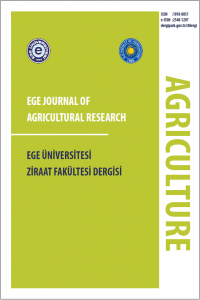Abstract
Amaç: Her yıl üzüm bağlarından önemli miktarda bağ budama artıkları ortaya çıkmaktadır. Bu artıklar önemli bir enerji potansiyeline sahiptir. Bu çalışmanın amacı bu artıkları pelet olarak değerlendirmektir.
Materyal ve Yöntem: Öğütülmüş bağ budama artıkları, iki farklı nem içeriğinde (yaklaşık %11 ve %15) ve üç farklı parçacık boyutunda (2, 4, 6 mm) pelet makinesinde çevre şartlarında peletlenmiştir. Peletlerin kalitesini belirleyen hacim yoğunluğu, parça yoğunluğu, mekanik dayanıklılık direnci, basınç direnci ve nem alma durumu gibi fiziksel özellikleri belirlenmiştir. Ayrıca, pelet makinesinin üretim kapasitesi ve enerji tüketim değerleri ölçülmüştür.
Araştırma Bulguları: Üretilen peletlerin fiziksel özellikleri materyal nem içeriği ve parçacık boyutuna bağlı olarak hacim ve parça yoğunluğu ortalama 696 kg m-3 ve 1262 kg m3, mekanik dayanıklılık direnci %91 ve gerilme direnci 2.36 N bulunmuştur. Ortalama üretim kapasitesi ise 45 kg h-1 olarak ölçülmüştür.
Sonuç: %11 ve %15 nem içeriğinde bağ budama artıklarından kaliteli peletler üretildi. Bu artıklardan elde edilen peletlerin fiziksel özellikleri literatür verileri ile uyumlu olduğu tespit edilmiştir.
References
- Kaliyan, Nalladurai and R. Vance Morey. 2009. “Factors Affecting Strength and Durability of Densified Biomass Products.” Biomass and Bioenergy 33(3):337–59.
- Liu, Zhijia, Benhua Fei, Zehui Jiang, Zhiyong Cai, and Xing’E Liu. 2014. “Important Properties of Bamboo Pellets to Be Used as Commercial Solid Fuel in China.” Wood Science and Technology 48(5):903–17.
- Liu, Zhijia, Zehui Jiang, Zhiyong Cai, Benhua Fei, YanYu, and Xing’e Liu. 2013. “Effects of Carbonization Conditions on Properties of Bamboo Pellets.” Renewable Energy 51:1–6.
- Mani, Sudhagar, Lope G. Tabil, and Shahab Sokhansanj. 2006. “Effects of Compressive Force, Particle Size and Moisture Content on Mechanical Properties of Biomass Pellets from Grasses.” Biomass and Bioenergy 30(7):648–54.
- Niedziółka, Ignacy, Mieczysław Szpryngiel, Magdalena Kachel-Jakubowska, Artur Kraszkiewicz, Kazimierz Zawiślak, Paweł Sobczak, and Rafał Nadulski. 2015. “Assessment of the Energetic and Mechanical Properties of Pellets Produced from Agricultural Biomass.” Renewable Energy 76:312–17.
- Özdoğan, Tuğçe and Hakan Geren. 2019. “Enerji Bitkisi Olarak Kullanılan Filotu (Miscanthus x Giganteus)’nda Farklı Azot Seviyelerinin Biyokütle Verimi ve Bazı Verim Özelliklerine Etkisi Üzerine Bir Ön Araştırma.” Ege Üniversitesi Ziraat Fakültesi Dergisi 56(2):141–50.
- Öztürk, Hasan Hüseyin. 2012. “Enerji Bitkileri ve Biyoyakıt Üretimi, Hasad Yayıncılık Ltd.” Hasad Yayıncılık Ltd 272.
- Ruiz Celma, A., F. Cuadros, and F. López-Rodríguez. 2012. “Characterization of Pellets from Industrial Tomato Residues.” Food and Bioproducts Processing 90(4):700–706.
- Soleimani, Majid, Xavier L. Tabil, Ramanpreet Grewal, and Lope G. Tabil. 2017. “Carbohydrates as Binders in Biomass Densification for Biochemical and Thermochemical Processes.” Fuel 193:134–41.
- Standard, E. C. 2009. CEN/TS 15103, Solid Biofuels, Determination of Bulk Density.
- Standard, E. C. 2012. CEN/TS 16127, Solid Biofuels, Determination of Length and Diameter of Pellets.
- TUIK. 2019. Türk İstatistik Ensititüsü.
Abstract
Objectives: Every year important amounts of vineyard pruning residues emerge from orchards. These residues have significant energy potential. The aim of this study is to evaluate these residues as pellet.
Material and Methods: Ground vineyard pruning residues were pelleted in environmental conditions in two different moisture contents (about 11% and 15%) and three different particle sizes (2, 4, 6 mm). The physical properties of pellets such as particle density, bulk density, durability, tensile strength and absorption resistance were defined. Besides, energy consumption values and pellet production capacity were measured.
Results: Depending on the material moisture content and particle size, the average bulk density, particle density, durability and tensile strength of pellets were found as 696 kg m-3, 1262 kg m-3, 91% and 2.36 MPa, respectively. The average production capacity was measured as 45 kg h-1.
Conclusion: Quality pellets were produced from vineyard pruning residues in the range of 11% and 15% moisture content. The physical properties of the pellets from these residues are in compliance with the literature data.
References
- Kaliyan, Nalladurai and R. Vance Morey. 2009. “Factors Affecting Strength and Durability of Densified Biomass Products.” Biomass and Bioenergy 33(3):337–59.
- Liu, Zhijia, Benhua Fei, Zehui Jiang, Zhiyong Cai, and Xing’E Liu. 2014. “Important Properties of Bamboo Pellets to Be Used as Commercial Solid Fuel in China.” Wood Science and Technology 48(5):903–17.
- Liu, Zhijia, Zehui Jiang, Zhiyong Cai, Benhua Fei, YanYu, and Xing’e Liu. 2013. “Effects of Carbonization Conditions on Properties of Bamboo Pellets.” Renewable Energy 51:1–6.
- Mani, Sudhagar, Lope G. Tabil, and Shahab Sokhansanj. 2006. “Effects of Compressive Force, Particle Size and Moisture Content on Mechanical Properties of Biomass Pellets from Grasses.” Biomass and Bioenergy 30(7):648–54.
- Niedziółka, Ignacy, Mieczysław Szpryngiel, Magdalena Kachel-Jakubowska, Artur Kraszkiewicz, Kazimierz Zawiślak, Paweł Sobczak, and Rafał Nadulski. 2015. “Assessment of the Energetic and Mechanical Properties of Pellets Produced from Agricultural Biomass.” Renewable Energy 76:312–17.
- Özdoğan, Tuğçe and Hakan Geren. 2019. “Enerji Bitkisi Olarak Kullanılan Filotu (Miscanthus x Giganteus)’nda Farklı Azot Seviyelerinin Biyokütle Verimi ve Bazı Verim Özelliklerine Etkisi Üzerine Bir Ön Araştırma.” Ege Üniversitesi Ziraat Fakültesi Dergisi 56(2):141–50.
- Öztürk, Hasan Hüseyin. 2012. “Enerji Bitkileri ve Biyoyakıt Üretimi, Hasad Yayıncılık Ltd.” Hasad Yayıncılık Ltd 272.
- Ruiz Celma, A., F. Cuadros, and F. López-Rodríguez. 2012. “Characterization of Pellets from Industrial Tomato Residues.” Food and Bioproducts Processing 90(4):700–706.
- Soleimani, Majid, Xavier L. Tabil, Ramanpreet Grewal, and Lope G. Tabil. 2017. “Carbohydrates as Binders in Biomass Densification for Biochemical and Thermochemical Processes.” Fuel 193:134–41.
- Standard, E. C. 2009. CEN/TS 15103, Solid Biofuels, Determination of Bulk Density.
- Standard, E. C. 2012. CEN/TS 16127, Solid Biofuels, Determination of Length and Diameter of Pellets.
- TUIK. 2019. Türk İstatistik Ensititüsü.
Details
| Primary Language | Turkish |
|---|---|
| Subjects | Engineering |
| Journal Section | Articles |
| Authors | |
| Publication Date | March 31, 2021 |
| Submission Date | April 20, 2020 |
| Acceptance Date | June 3, 2020 |
| Published in Issue | Year 2021 Volume: 58 Issue: 1 |







